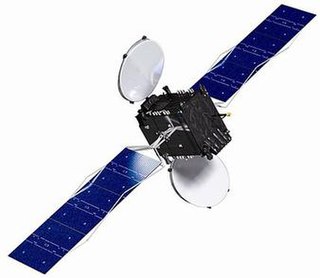MEASAT Satellite Systems Sdn. Bhd., formerly Binariang Satellite Systems Sdn. Bhd., is a Malaysian communications satellite operator that owns and operates the MEASAT and AFRICASAT spacecraft. The company provides satellite services to leading Malaysian broadcasters Direct-To-Home, (DTH) platforms and telecom operators. With capacity across six communication satellites, the company provides satellite services to over 150 countries.

The Arab Satellite Communications Organization is a communications satellite operator in the Arab World, headquartered in the city of Riyadh, Saudi Arabia. Arabsat was created to deliver satellite-based, public and private telecommunications services to the Arab States, in accordance with International Standards. With 21 member countries, the organization plays a vital role of enhancing communications in the Arab World.
Yuri, also known as Broadcasting Satellite or BS, was a series of Japanese direct broadcast satellites.
AMOS-1, then INTELSAT 24, is a commercial communications satellite which was operated by Spacecom as AMOS-1, for Affordable Modular Optimized Satellite and formed part of the AMOS series of satellites. It was the first Israeli civilian communications satellite, and was initially positioned at 4° West longitude in geostationary orbit. Then in September 2011, it was moved to 31° East.
MNC Vision, previously known as Indovision, is a direct-to-home satellite television and radio service that operates in Indonesia on a subscription basis. It is owned by PT MNC Vision Networks Tbk, which is a subsidiary of MNC Asia Holding. MNC Vision is the oldest subscription-based television service in Indonesia and is known for its slogan "Pay TV Keluarga Indonesia," which means "Pay TV for Indonesian Families."
Intelsat 2, formerly PAS-2, was a communications satellite operated by Intelsat which spent most of its operational life serving the Pacific Rim market from a longitude of 169° East. Launched in July 1994, the satellite was operated by PanAmSat until it merged with Intelsat in 2006. The spacecraft was renamed, along with the rest of PanAmSat's fleet, on 1 February 2007.
Intelsat 3R is a communications satellite owned by Intelsat located at 43° West longitude, serving the Americas market.

Star Bus is a satellite bus family of Orbital ATK. It was originally developed by Thomas van der Heyden, co-founder of CTAI, and later sold to and manufactured by Orbital Sciences Corporation.
ProtoStar Ltd was a private company incorporated in Bermuda, with U.S. operations based in San Francisco, California and Asian operations based in Singapore. ProtoStar intended to operate an initial fleet of three geostationary satellites. Two satellites were acquired and launched. ProtoStar's anchor customer, Dish TV India Limited, is the largest direct-to-home television operator in India.
SES-7 is a commercial communications satellite operated by SES World Skies, then SES S.A.
Eutelsat 21B, previously known as Eutelsat W6A, is a French communications satellite. Operated by Eutelsat, it provides direct to home broadcasting services from geostationary orbit at a longitude of 21.5 degrees east. It replaced the Eutelsat 21A spacecraft which was launched in 1999.
Türksat 1C was a Turkish communications satellite as part of a project to form an instant network with two geosynchronous satellites that is supervised by the companies Türksat A.Ş. in Turkey and Aérospatiale of France.
JCSAT-4B, known as JCSAT-13 before launch, is a geostationary communications satellite operated by SKY Perfect JSAT Group (JSAT) which was designed and manufactured by Lockheed Martin on the A2100 platform.
BSAT-2a, was a geostationary communications satellite operated by B-SAT which was designed and manufactured by Orbital Sciences Corporation on the STAR-1 platform. It was stationed on the 110° East orbital slot along its companion BSAT-2c from where they provided redundant high definition direct television broadcasting across Japan.
BSAT-2b, was a geostationary communications satellite ordered by B-SAT which was designed and manufactured by Orbital Sciences Corporation on the STAR-1 platform. It was designed to be stationed on the 110° East orbital slot along its companion BSAT-2a where it would provide redundant high definition direct television broadcasting across Japan.
BSAT-2c, was a geostationary communications satellite operated by B-SAT and was designed and manufactured by Orbital Sciences Corporation on the STAR-1 platform. It was stationed on the 110° East orbital slot along its companion BSAT-2a from where they provided redundant high definition direct television broadcasting across Japan.
The GEOStar is a family of satellite buses designed and manufactured by Northrop Grumman Innovation Systems. The family started focused on small geostationary communications satellites. The first iterations focused on the sub-5 kW commercial segment that was left vacated after the retirement of the HS-376 satellite bus. It started with the STARBus on CTA Space Systems, which was later bought successively by Orbital Sciences, Orbital ATK, and most recently Northrop Grumman Innovation Systems.
Eutelsat 8 West B is a geostationary communications satellite. Operated by Eutelsat, it provides direct-to-home (DTH) broadcasting services from geostationary orbit. The satellite is part of Eutelsat's constellation at a longitude of 8° West. Eutelsat announced the order of a new Spacebus-4000C3 satellite bus from Thales Alenia Space in October 2012.
Eutelsat 12 West B, known as Atlantic Bird 2 prior to 2012 and Eutelsat 8 West A from 2012 to 2015, was a geostationary communications satellite. Operated by Eutelsat, it provides direct-to-home (DTH) broadcasting services from geostationary orbit. The satellite is part of Eutelsat constellation at a longitude of 8° West, then 12.5° West. Eutelsat announced the order of a new Spacebus-3000B2 satellite bus from Alcatel Space in October 2012.
Palapa-C2 was an Indonesian communications satellite which reached its target orbit on 16 May 1996. It was built by Hughes Space and Communications Company for Indonesian telecommunications provider PT Satelit Palapa Indonesia (SATELINDO). It was based on the HS-601 satellite bus and had 30 C-band transponders and 4 Ku-band transponders. It was due to be located in geosynchronous orbit at 113° East above the equator. It operated for more than 20 years, more than five years past the designed life time of 15 years, making it the longest operation among the Indonesian fleet of communications satellites.

